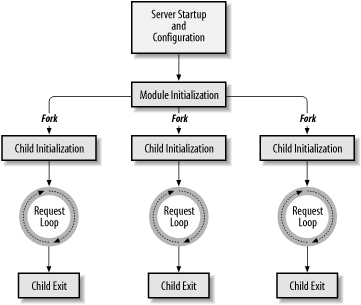1.2.1. Forking
Apache 1.3 on all Unix flavors uses the forking model.[8] When you start the server, a single process, called the parent process, is started. Its main responsibility is starting and killing child processes as needed. Various Apache configuration directives let you control how many child processes are spawned initially, the number of spare idle processes, and the maximum number of processes the parent process is allowed to fork.
[8]In Chapter 24 we talk about Apache 2.0, which introduces a few more server models.
Each child process has its own lifespan, which is controlled by the configuration directive MaxRequestsPerChild. This directive specifies the number of requests that should be served by the child before it is instructed to step down and is replaced by another process. Figure 1-3 illustrates.

Figure 1-3. The Apache 1.3 server lifecycle
When a client initiates a request, the parent process checks whether there is an idle child process and, if so, tells it to handle the request. If there are no idle processes, the parent checks whether it is allowed to fork more processes. If it is, a new process is forked to handle the request. Otherwise, the incoming request is queued until a child process becomes available to handle it.
The maximum number of queued requests is configurable by the ListenBacklog configuration directive. When this number is reached, a client issuing a new request will receive an error response informing it that the server is unreachable.
This is how requests for static objects, such as HTML documents and images, are processed. When a CGI request is received, an additional step is performed: mod_cgi in the child Apache process forks a new process to execute the CGI script. When the script has completed processing the request, the forked process exits.
Continue to:


